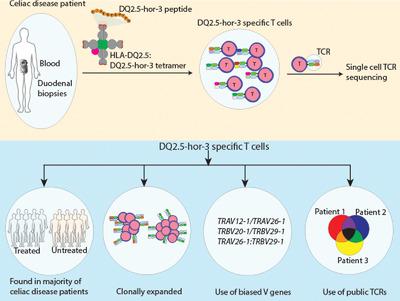当前位置:
X-MOL 学术
›
Eur. J. Immunol.
›
论文详情
Our official English website, www.x-mol.net, welcomes your
feedback! (Note: you will need to create a separate account there.)
On the immune response to barley in celiac disease: Biased and public T-cell receptor usage to a barley unique and immunodominant gluten epitope.
European Journal of Immunology ( IF 4.5 ) Pub Date : 2019-10-19 , DOI: 10.1002/eji.201948253 Shiva Dahal-Koirala 1, 2, 3 , Ralf S Neumann 1, 2, 3 , Jørgen Jahnsen 3, 4 , Knut E A Lundin 1, 3, 5 , Ludvig M Sollid 1, 2, 3
European Journal of Immunology ( IF 4.5 ) Pub Date : 2019-10-19 , DOI: 10.1002/eji.201948253 Shiva Dahal-Koirala 1, 2, 3 , Ralf S Neumann 1, 2, 3 , Jørgen Jahnsen 3, 4 , Knut E A Lundin 1, 3, 5 , Ludvig M Sollid 1, 2, 3
Affiliation

|
Celiac disease (CeD) is driven by CD4+ T-cell responses to dietary gluten proteins of wheat, barley, and rye when deamidated gluten epitopes are presented by certain disease-associated HLA-DQ allotypes. About 90% of the CeD patients express HLA-DQ2.5. In such patients, five gluten epitopes dominate the anti-gluten T-cell response; two epitopes unique to wheat, two epitopes present in wheat, barley, and rye and one epitope unique to barley. Despite presence of barley in commonly consumed food and beverages and hence being a prominent source of gluten, knowledge about T-cell responses elicited by barley in CeD is scarce. Therefore, in this study, we explored T-cell response toward the barley unique epitope DQ2.5-hor-3 (PIPEQPQPY) by undertaking HLA-DQ:gluten peptide tetramer staining, single-cell T-cell receptor (TCR) αβ sequencing, T-cell cloning, and T-cell proliferation studies. We demonstrate that majority of the CeD patients generate T-cell response to DQ2.5-hor-3, and this response is characterized by clonal expansion, preferential TCR V-gene usage and public TCR features thus echoing findings previously made for wheat gluten epitopes. The knowledge that biased and public TCRs underpin the T-cell response to all the immunodominant gluten epitopes in CeD suggests that such T cells are promising diagnostic and therapeutic targets.
中文翻译:

关于乳糜泻对大麦的免疫反应:对大麦独特且具有免疫优势的面筋表位的偏见和公共T细胞受体使用情况。
当某些疾病相关的HLA-DQ同种异型呈现脱酰胺的面筋表位时,乳糜泻(CeD)由CD4 + T细胞对小麦,大麦和黑麦的膳食面筋蛋白的应答所驱动。大约90%的CeD患者表达HLA-DQ2.5。在这类患者中,五种面筋抗原决定簇在抗面筋T细胞反应中占主导。小麦具有两个独特的表位,小麦,大麦和黑麦具有两个表位,而大麦则具有一个表位。尽管大麦存在于通常食用的食品和饮料中,因此是面筋的主要来源,但关于大麦在CeD中引起的T细胞反应的知识却很少。因此,在这项研究中,我们通过进行HLA-DQ:谷蛋白肽四聚体染色,单细胞T细胞受体(TCR)αβ测序,探索了对大麦独特表位DQ2.5-hor-3(PIPEQPQPY)的T细胞反应,T细胞克隆,和T细胞增殖研究。我们证明大多数CeD患者产生对DQ2.5-hor-3的T细胞应答,并且该应答的特征是克隆扩增,TCR V基因优先使用和公共TCR特征,因此呼应了以前对小麦面筋表位的发现。有偏见和公开的TCRs构成了对CeD中所有免疫显性麸质表位的T细胞反应的基础,这表明这种T细胞是有希望的诊断和治疗靶标。
更新日期:2019-11-13
中文翻译:

关于乳糜泻对大麦的免疫反应:对大麦独特且具有免疫优势的面筋表位的偏见和公共T细胞受体使用情况。
当某些疾病相关的HLA-DQ同种异型呈现脱酰胺的面筋表位时,乳糜泻(CeD)由CD4 + T细胞对小麦,大麦和黑麦的膳食面筋蛋白的应答所驱动。大约90%的CeD患者表达HLA-DQ2.5。在这类患者中,五种面筋抗原决定簇在抗面筋T细胞反应中占主导。小麦具有两个独特的表位,小麦,大麦和黑麦具有两个表位,而大麦则具有一个表位。尽管大麦存在于通常食用的食品和饮料中,因此是面筋的主要来源,但关于大麦在CeD中引起的T细胞反应的知识却很少。因此,在这项研究中,我们通过进行HLA-DQ:谷蛋白肽四聚体染色,单细胞T细胞受体(TCR)αβ测序,探索了对大麦独特表位DQ2.5-hor-3(PIPEQPQPY)的T细胞反应,T细胞克隆,和T细胞增殖研究。我们证明大多数CeD患者产生对DQ2.5-hor-3的T细胞应答,并且该应答的特征是克隆扩增,TCR V基因优先使用和公共TCR特征,因此呼应了以前对小麦面筋表位的发现。有偏见和公开的TCRs构成了对CeD中所有免疫显性麸质表位的T细胞反应的基础,这表明这种T细胞是有希望的诊断和治疗靶标。









































 京公网安备 11010802027423号
京公网安备 11010802027423号